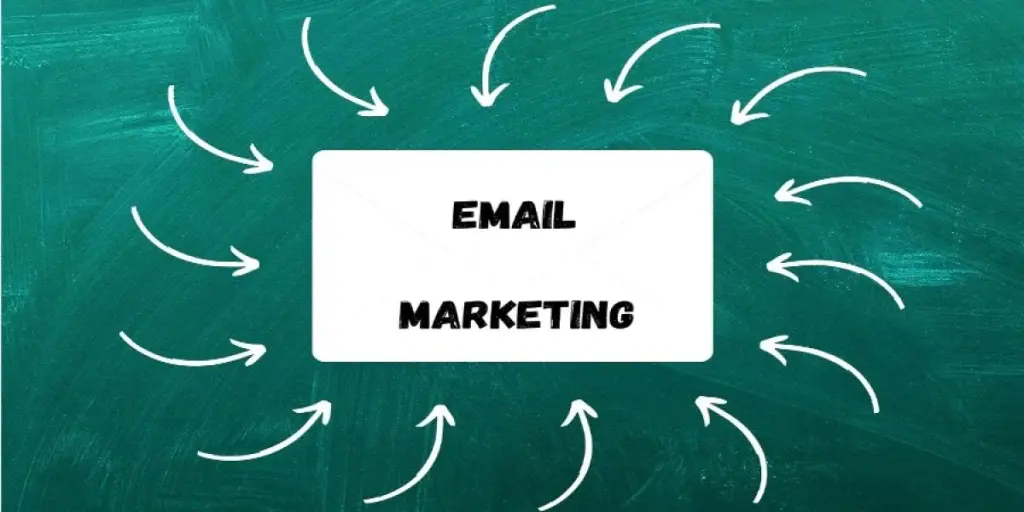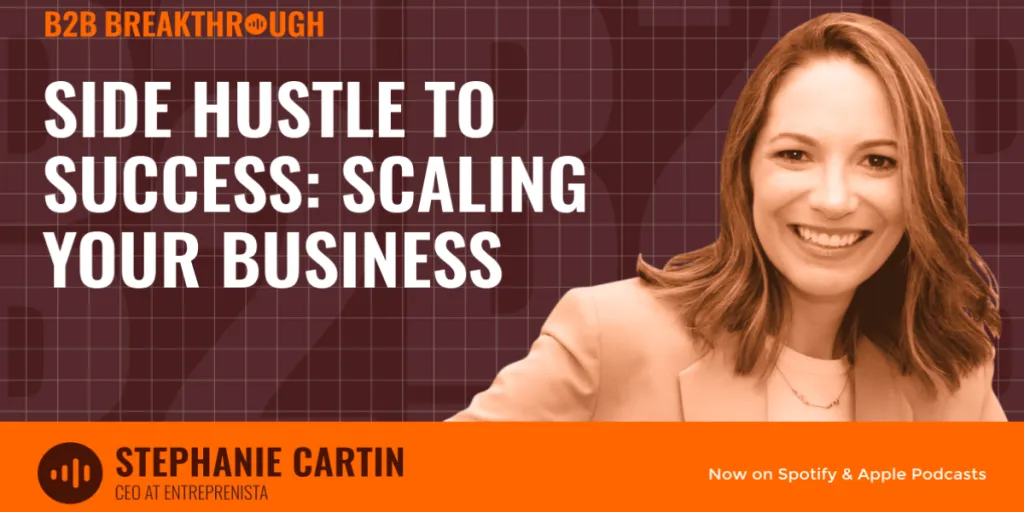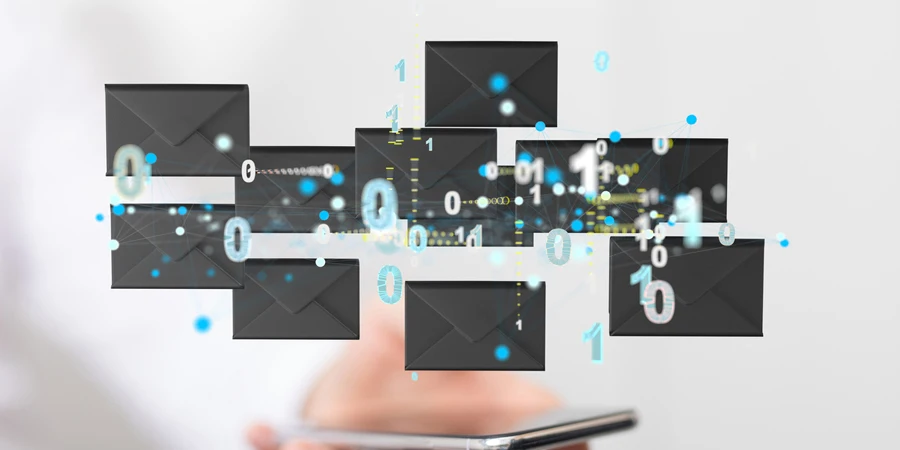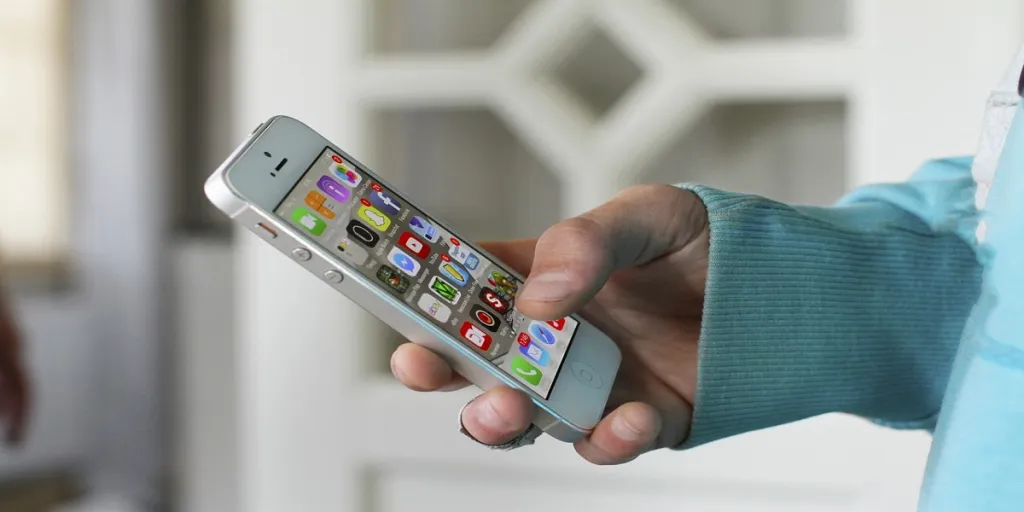Are you looking for an effective way to reach out to your target audience and promote your brand? Look no further than email marketing campaigns.
With their high ROI and versatility, email campaigns have become a staple for businesses of all sizes.
From welcome messages and newsletter emails to cart recovery and win-back sequences, there are various types of email campaigns that can help increase your engagement and conversions.
In this post, we’ll explore different types of email marketing campaigns with examples and provide tips on how you can create your own successful campaign.
In this post:
- What is an email marketing campaign?
- Types of email marketing campaigns
- How to create an email marketing campaign (5 steps)
Setting up my signup forms, abandoned cart recovery emails and launching my first campaign was easy. In fact, before I even started my campaign, I had already recovered multiple abandoned carts!
Prince M.,
Verified Omnisend review from G2
What is an email marketing campaign?
An email marketing campaign refers to a marketing strategy where a series of distinct email messages are sent out over a defined time frame to a specific group of people. The objectives of each of these emails can vary.
From installing an app, completing a purchase, or downloading a report—you can choose goals from across the sales funnel.
95% of marketers, in a HubSpot survey, said email marketing campaigns helped them achieve business goals such as generating leads or boosting brand awareness.
Omnisend’s research also shows that promotional emails, with a click-to-conversion rate of 6.74%, are effective at generating sales.
Here’s an example of Duolingo’s email marketing campaign. The first one is a welcome email, while the second email, sent after a week, includes a weekly progress report. The third email is sent when the user has been inactive for a while.
Email subject line: Welcome to Duolingo! Here are 2 important tips.

Email subject line: 📆 Congrats on your first week! Check out your progress
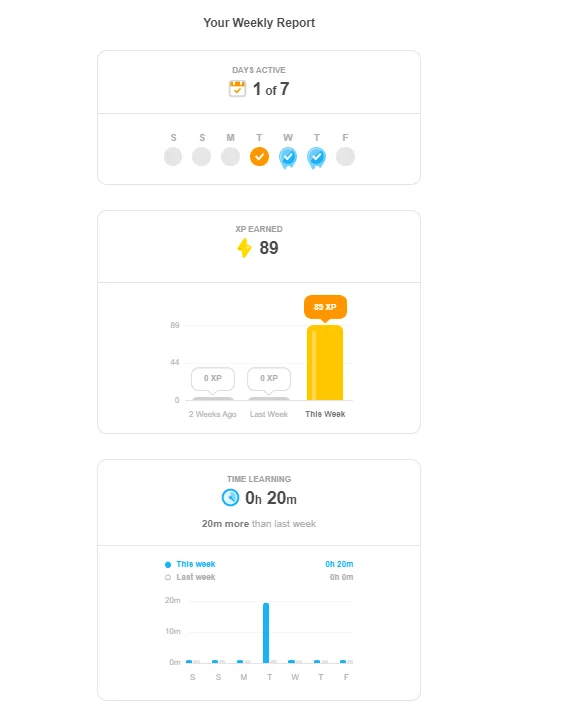
Email subject line:👋 [Name], Duo missed you yesterday!
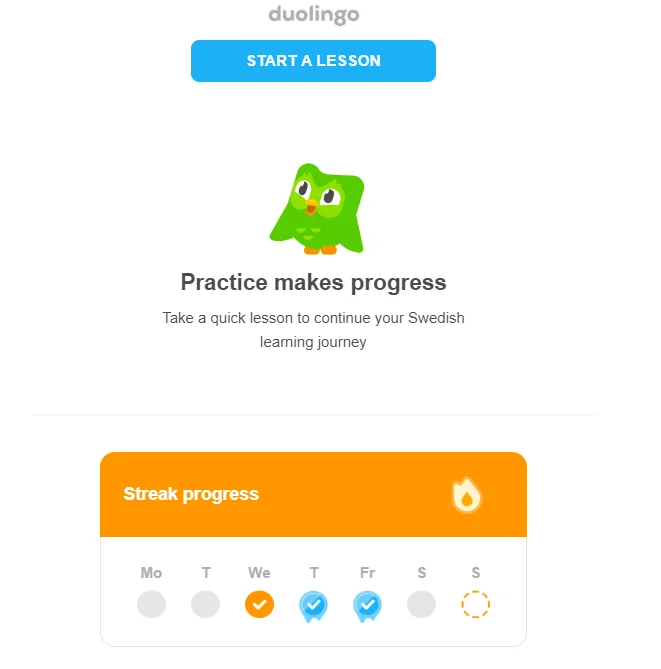
Types of email marketing campaigns
Let’s now take a look at the various types of email marketing campaigns you can launch for your business.
1. Welcome emails
A well-crafted welcome email can make a positive first impression on new subscribers and set the tone for future interactions. Personalizing the welcome email with the recipient’s name and other relevant information, can help make the message even more relevant and engaging.
As mentioned in our ecommerce statistics report, welcome emails had the highest conversion rates of 52.9% among all marketing messages. This makes welcome emails ideal for promoting products/services.
While customers expect to receive a welcome email when they sign up, B2B brands can take this opportunity to introduce their company, its values, and its products or services.
And, this is exactly what brands such as To’ak Chocolate do.
Our automated welcome series allows us to share our brand story with anyone who subscribes, which helps us communicate the uniqueness of our brand. We tell the story from the founder’s perspective, the farmer’s perspective, and from other voices. Today, customers get a personalized introduction to our brand.
James Le Compte
CEO at To’ak Chocolate
Here’s another example of a welcome email from A Kids Book About that showcases its brand story, mission, and team.
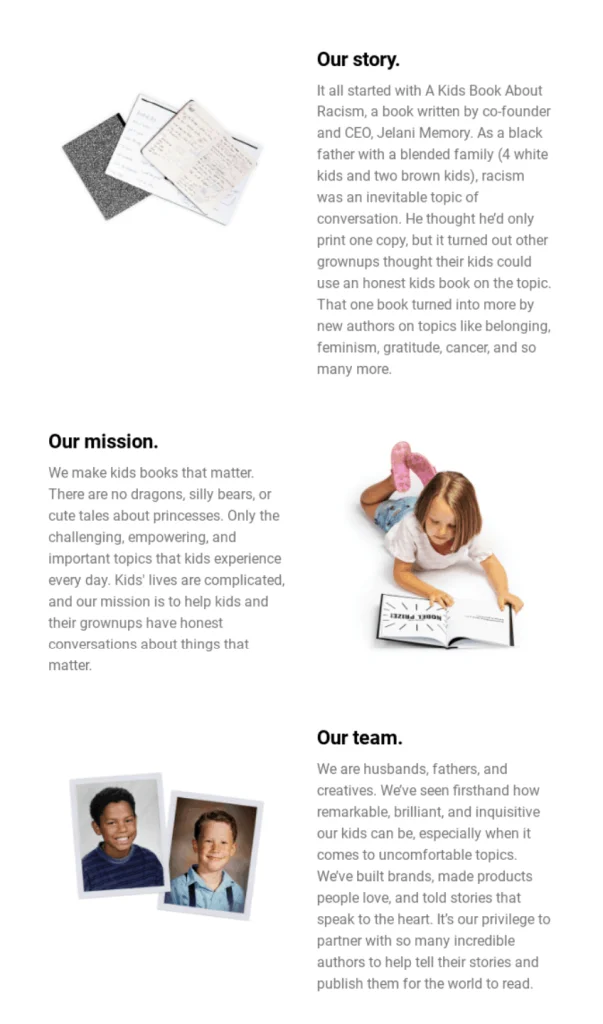
Tips for welcome emails:
- Personalize your welcome emails: Tailor the email subject line and content based on the information you have about your recipients.
- Introduce your brand: While keeping the tone warm and friendly, highlight your brand’s USPs and the benefits of subscribing to your email.
- Offer something valuable: Entice recipients to engage with your brand by offering a welcome discount, valuable tips, or explaining the next steps.
2. Lead nurturing emails
These are a series of targeted email messages that can help build a relationship with prospects and guide them through the buyer’s journey. The goal here is to ensure your brand stays on top of your prospects’ minds and convert them into paying customers.
The content of lead nurturing emails may vary depending on the stage of the buyer’s journey. For example, early-stage prospects can receive emails with educational content, while later-stage prospects may receive targeted offers.
Here’s an engaging lead nurturing email from JetBlue that uses a generous sprinkle of puns and humor to convert customers and leads into TrueBlue members.
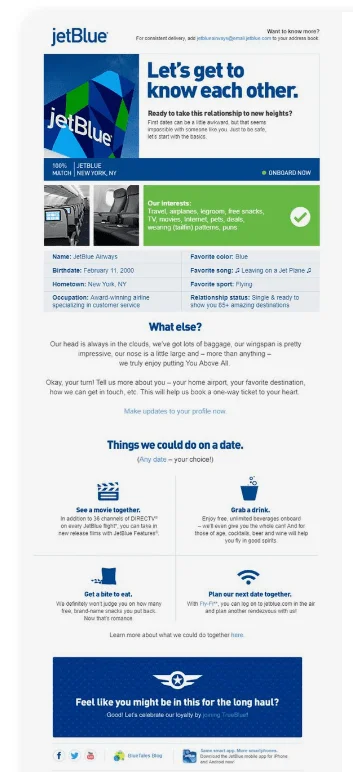
[Omnisend’s] segmenting feature combined with reporting is really cool. We can see what a person bought in the last six months, and then send a recipe that matches the product they bought. It makes it possible to really dive in and get it right with customers.
Craig Hastings
Culinary Director at Baking Steel
Tips for lead nurturing emails:
- Segment your list: Divide your leads into different segments based on their interests, behavior, and buying stage. This will allow you to tailor your messages to their specific needs.
- Use a compelling subject line: Your subject line should grab the recipient’s attention and entice them to open the email. Make it clear what the email is about and what’s in it for them.
- Add a clear call-to-action: Tell the recipient what you want them to do next, such as downloading a white paper, scheduling a demo, or signing up for a free trial.
3. Newsletter emails
Newsletter emails are a powerful marketing tool that can help brands establish themselves as thought leaders and stay connected with their targets. By offering valuable content regularly, you can boost brand memory and recall.
According to Statista, 86% of marketers agree that email newsletters offer an important “connection point” with their consumers and 88% say that email newsletters are a valuable way to target consumers.
While newsletters can feature industry news, Fiverr uses email newsletters to share how they helped other businesses achieve their goals.
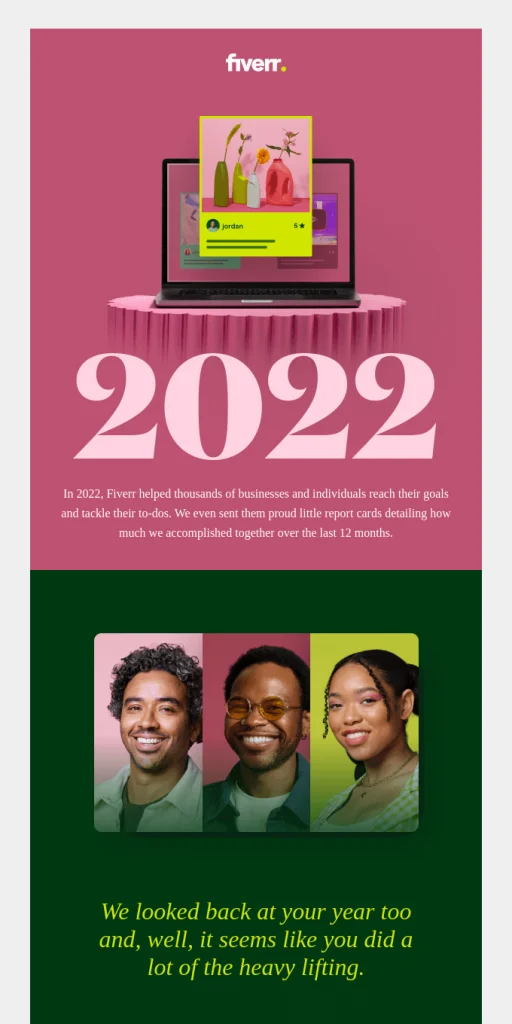
Tips for newsletter emails:
- Provide exclusive content: Share educational content, industry insights, special offers, and other useful information that your recipients may not find elsewhere.
- Ensure the design is user-friendly: Use striking visuals and break up the stories into bite-sized segments to improve readability.
- Focus on the reader: Using pronouns, first names, and humor is a great way to build a personal connection with the readers.
4. Transactional emails
These are emails that are sent after someone takes an action on a brand’s website such as making a purchase, downloading a report, or changing a password.
Unlike bulk marketing emails, transactional emails are relevant to a specific recipient and their action.
There are so many ways to use transactional emails. For instance, you can send an order confirmation email with a CTA to sign up for newsletters. Or, you can add multiple CTAs in your transactional emails to direct recipients to other sections of your website.
In this transactional email, Holo Taco encourages its customers to leave a review and earn loyalty points.

Tips for transactional emails:
- Keep it concise: Ensure your emails are short and to the point. Use clear and concise language to communicate the necessary details.
- Test and adjust: A/B test elements of your transactional emails, such as subject lines and content, to see what works best.
- Make it visually appealing: Use an attractive and simple design, but avoid using too many images or graphics as they can distract readers and make your emails heavy.
5. Product upsell emails
The goal of product upsell emails is to increase the average order value (AOV) of each customer by encouraging them to buy more products. By offering personalized product recommendations, brands can improve customer experience and build loyalty.
SaaS companies, for instance, can send upsell emails at the end of a free trial to promote their paid plans. These emails can also be sent when the user reaches a milestone or when a company launches a new product or upgrades its features.
In this product upsell email, Grammarly promotes its premium plan by explaining the benefits of upgrading and adds a clear CTA.
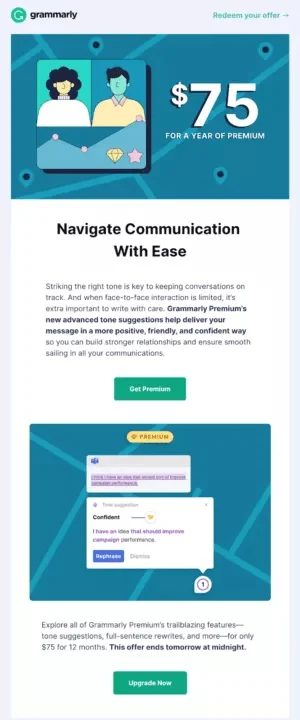
Tips for product upsell emails:
- Use persuasive language: Highlight the benefits of the products to make it easy for customers to understand why they should consider making an additional purchase.
- Personalize your emails: Use segmentation and make product recommendations based on the recipient’s previous purchases/browsing behavior.
- Provide an incentive: An attractive discount can be a powerful motivator for customers to make an additional purchase. Don’t forget to add a sense of urgency.
6. Cart recovery emails
These emails are designed to encourage customers to return to their abandoned cart and complete the purchase. By providing personalized product recommendations or sending a friendly reminder, businesses can show that they value their customers.
When done well, cart recovery emails can help you boost conversions and sales. In fact, cart recovery emails have one of the highest conversion rates at 39.7%, according to Omnisend research. Other studies show these emails have an open rate of 49.49%.
Here’s a cart recovery email from Pipcorn Heirloom Snacks that offers an incentive and a reminder to head back to the cart.

Tips for cart recovery emails:
- Send at the right time: Make the most of your target’s shopping urge by sending the first email an hour after they abandon the cart. Send the second email 12 hours later, and the third, 24 hours later.
- Feature the abandoned product: This is a great way of reminding your users about the product they abandoned.
- Provide support: Give your audience easy ways to reach out to you for any questions or obstacles they may be facing in completing their purchase.
7. Win-back emails
Win-back or retargeting emails can help you boost marketing ROI by cutting down on the cost of new customer acquisition. A recent study shows the customer acquisition cost (CAC) can be as high as $500 to $1000 across industries.
Besides, Omnisend’s research shows that lapsed purchase emails have conversion rates that are 460% higher than promotional emails. You can use win-back emails to re-engage with customers, increase customer lifetime value (CLV), and build customer loyalty.
YouTube TV does a great job of reaching out to inactive customers by highlighting the benefits of resubscribing and well-placed CTAs.
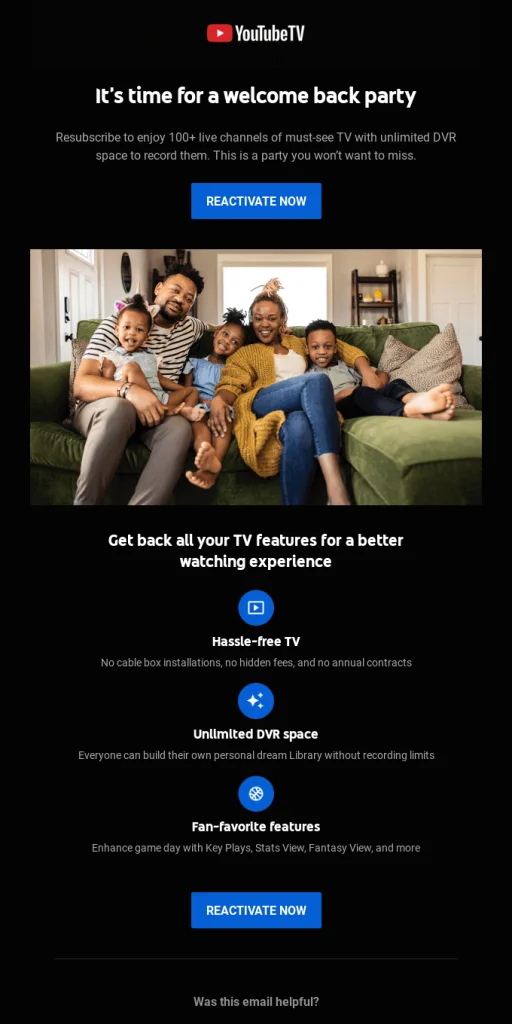
Tips for win-back emails:
- Fine-tune audience segments: Analyze customer behavior and segment based on their level of activity.
- Time it right: Based on your target segmentation and goals, you may need to send reactivation emails within two weeks of inactivation or wait for 90 days or more.
- Optimize the subject line: Using a combination of “$ discount” and words like “come back” can help. But, split test to know the best subject line to use.
How to create an email marketing campaign
Let’s now take a look at the steps you can follow to create your email campaign. But first, you’ll need an email marketing app for it.
For this example, we’ll be using Omnisend.
And why’s that?
Well, you can start using it for free (for life). It’s also got an easy-to-use editor, and a 4.5 rating (out of 5) from users.
The best part? It takes less than a minute to sign up. Get started now.
Let’s now understand the steps for creating your email campaign.
Step 1: Add subject line & preheader
First, sign up for a free account by downloading the Omnisend app or by signing up on Omnisend’s website.
Now, go to the ‘Campaigns’ tab in your account and click on ‘New Campaign > Create Campaign under Email.
In Campaign settings, add the subject line and the preheader.
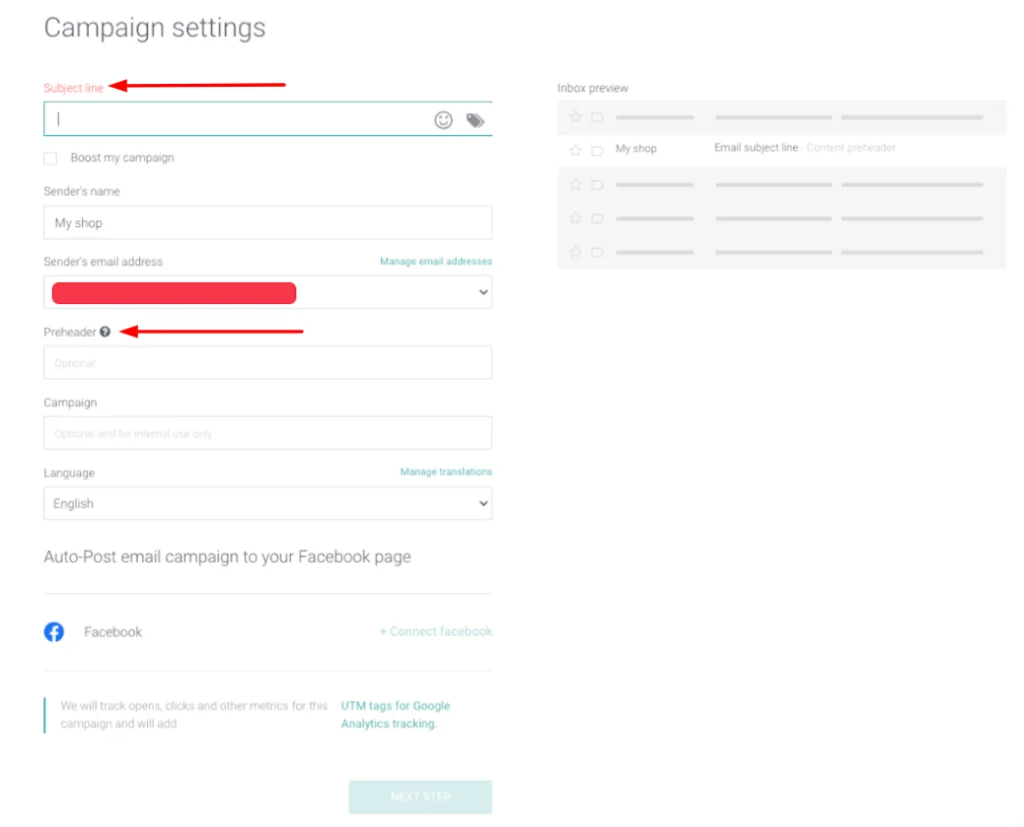
While there is no specific character limit for your email subject line, inboxes show a truncated part of the subject line as a preview. When you enter the subject line in the Campaign settings, an inbox preview is displayed next to the subject line field. This can give you a good idea of the ideal length for your subject line.
Step 2: Choose a campaign template
Omnisend offers a wide range of responsive email templates that are customizable and free. You can filter these templates by goals (welcome and engage, product promotion, sale, or discount) to find the right one for your email marketing campaign.
You can also create a custom design from scratch by choosing one of the pre-built layouts and modifying the template. After creating your custom template, you can save it and use it for all your email marketing campaigns.
To get started, select the goal on the left side and choose the template.
Here, I’ll choose the “Welcome & engage” template.
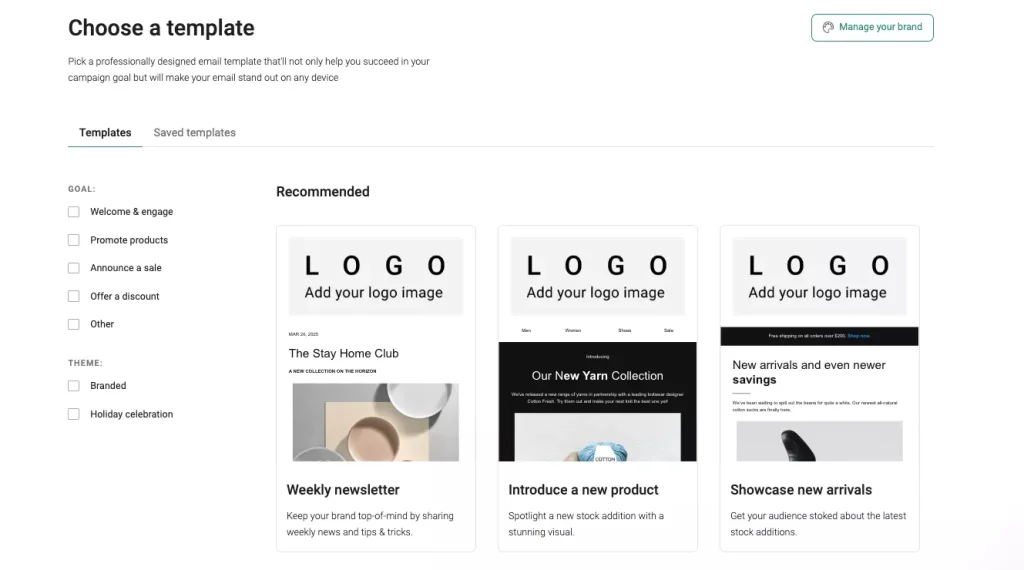
Step 3: Add the content
The next step is to add the content to your emails.
Here are the elements to add:
- Logo: Under the Header tab in the left-hand sidebar, you can find the option to add the logo and the image.
- Email body: You can add new content to improve the existing content in the templates or change it entirely. It’s also possible to add a discount, social media buttons, and lines at this stage.
- Images: Drag and drop an image from the left sidebar, click on the image, and then click “Replace” on the right sidebar. Choose an image from your image library.
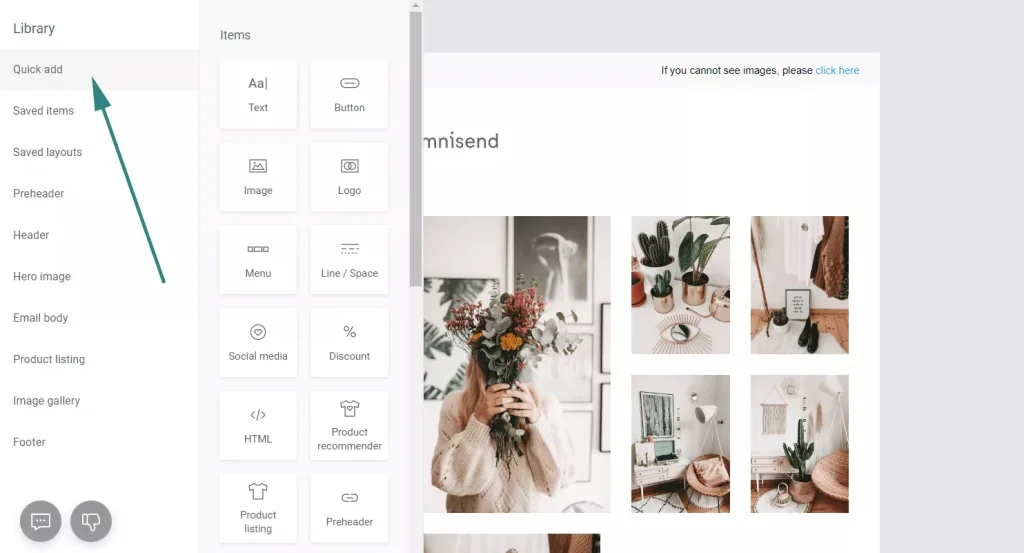
Click Finish Editing once you’re done.
Your email is now ready.
You can send a test email to see how it would look in your recipients’ inboxes.
Step 4: Select recipients
Depending on your email marketing goals, you can send your emails to all subscribers or a specific segment.
Omnisend’s campaign builder gives you an option to exclude certain subscribers from your contact list. You can select the ‘’Exclude segment’ option to ensure your email is not sent to specific customers (such as inactive customers or those who have already received your welcome emails).
You can also select the “Let me choose segments” option to specify who you want the emails to be sent to.

Step 5: Send the campaign
Check all the elements such as the recipient list, images, text, and header before clicking on the “Send now” button.
Or, select the ‘Schedule for later’ option if you want to send the email at a later date and time.
Once you click on “Send now”, the email will be sent within 5 minutes to your chosen recipients.
Note that there may be a delay in sending emails if this is your first email campaign. We follow a verification process where we send the email to a small batch, check the spam and bounce rates, and then send the email to other contacts.

Email marketing campaigns: summary
Email marketing campaigns are cost-effective and incredibly powerful tools to reach target audiences, increase engagement, and boost conversions.
The key is to understand your target audiences and study their behavior to segment them into specific groups. This will allow you to create and send targeted marketing messages that are likely to result in high open and conversion rates.
Utilizing the best practices discussed in this article will help you create successful email marketing campaigns that not only drive conversions but also build long-term customer relationships.
Source from Omnisend
Disclaimer: The information set forth above is provided by Omnisend independently of Alibaba.com. Alibaba.com makes no representation and warranties as to the quality and reliability of the seller and products.
